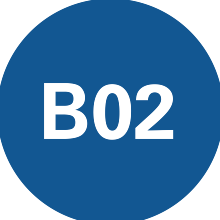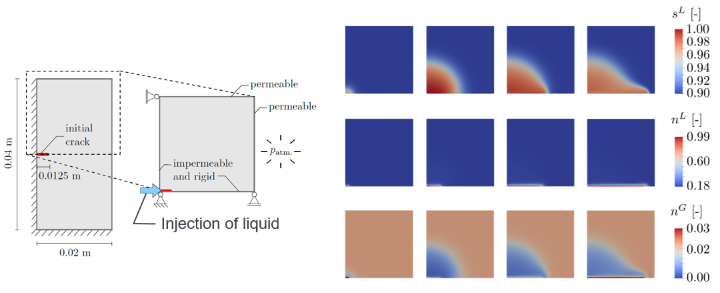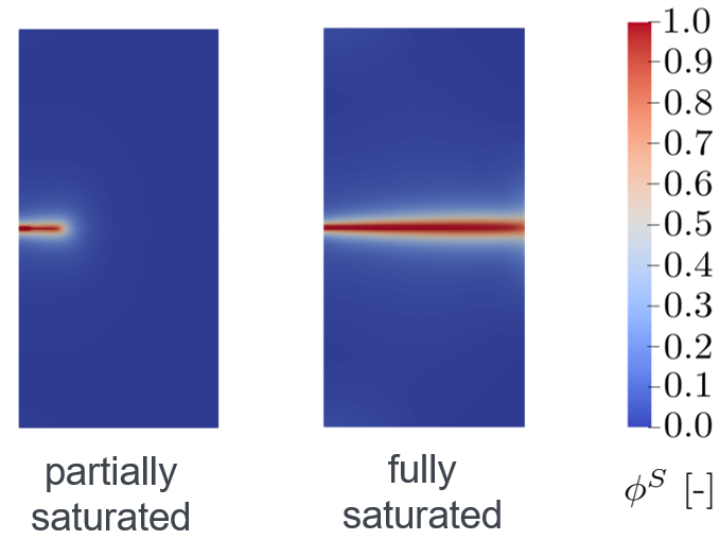People
Alixa Sonntag (Alumna)
Jan Lukas Eurich (Alumnus)
Publications
Publications in scientific journals
Book contributions
- Ehlers, W., Sonntag, A., & Wagner, A. (2022). On Hydraulic Fracturing in Fully and Partially Saturated Brittle Porous Material. In F. Aldakheel, B. Hudobivnik, M. Soleimani, H. Wessels, C. Weißenfels, & M. Marino (Eds.), Current Trends and Open Problems in Computational Mechanics (pp. 111--119). Springer International Publishing. https://doi.org/10.1007/978-3-030-87312-7_12
(Journal-) Articles
- Wagner, A., Sonntag, A., Reuschen, S., Nowak, W., & Ehlers, W. (2023). Hydraulically induced fracturing in heterogeneous porous media using a TPM-phase-field model and geostatistics. PAMM, 23(1), Article 1. https://doi.org/10.1002/pamm.202200118
- Sonntag, A., Wagner, A., & Ehlers, W. (2023). Dynamic hydraulic fracturing in partially saturated porous media. Computer Methods in Applied Mechanics and Engineering, 414, 116121. https://doi.org/10.1016/j.cma.2023.116121
- Ehlers, W. (2023). A historical review on porous-media research. PAMM. https://doi.org/10.1002/pamm.202300271
- Wagner, A., Eggenweiler, E., Weinhardt, F., Trivedi, Z., Krach, D., Lohrmann, C., Jain, K., Karadimitriou, N., Bringedal, C., Voland, P., Holm, C., Class, H., Steeb, H., & Rybak, I. (2021). Permeability Estimation of Regular Porous Structures: A Benchmark for Comparison of Methods. Transport in Porous Media, 138, 1–23. https://doi.org/10.1007/s11242-021-01586-2
- Sonntag, A., Wagner, A., & Ehlers, W. (2021). Modelling fluid-driven fractures for partially saturated porous materials. PAMM, 20(1), Article 1. https://doi.org/10.1002/pamm.202000033
- Ehlers, W., & Wagner, A. (2019). Modelling and simulation methods applied to coupled problems in porous-media mechanics. Archive of Applied Mechanics. https://doi.org/10.1007/s00419-019-01520-5
Research
About the project
We describe fracturing porous solids with arbitrary pore content by two basic ingredients, the macroscopic Theory of Porous Media and the phase-field approach to fracturing. Initially, the solid is treated as a brittle elastic material that is permeable for arbitrary fluids in the sense of a Darcian pore-fluid flow. Under hydraulic fracturing conditions, cracks will open depending on fluid pressure and solid strength, and the fluid flow in the cracked zones changes from purely Darcian to Stokean type. Interfaces between the solid and the pore fluid are contributing to hydraulic-conductivity and fracturing conditions.
Results
The aim of this project is to approach methodical developments to enlarge the understanding of the coupled processes occurring during fluid-driven fracturing in partially saturated porous media. Application examples are rocks or soil in the vadose zone under hydraulic-fracturing conditions. Therefore, a triphasic modelling approach with liquid and air filling the pore space of the solid skeleton was considered. This project has studied the effect of the interaction among the fluid phases during a fluid-driven crack propagation. Hereby, the coupled behaviour of the three phases has been described on the REV-scale within the continuum-mechanical framework of the Theory of Porous Media (TPM). In addition, the fracturing process has been modelled with a phase-field approach, where the damaged state of the solid skeleton is described with a scalar phase-field variable. The phase-field variable is smoothed out according to a length-scale parameter. This leads to a diffuse transition zone between the two extreme states of intact and fully broken material. We developed and implemented TPM-phase-field models and showed that the interaction of the fluid phases and especially the compressibility of the gas hinder the crack propagation in the partially saturated porous medium compared to the same fracturing process in a fully saturated porous medium.
For further information please contact

Arndt Wagner
Dr.-Ing.Principal Investigator, Research Project B02
[Photo: Max Kovalenko]

Wolfgang Ehlers
Prof. Dr.-Ing. Dr. h.c.Advisory Board





